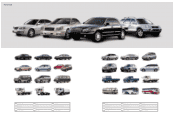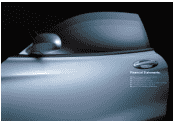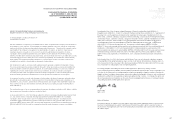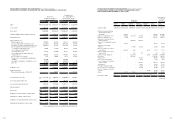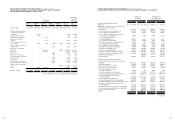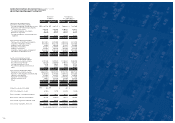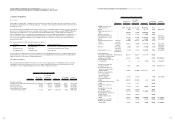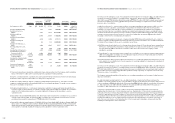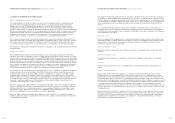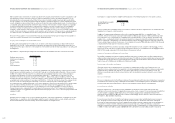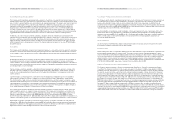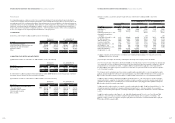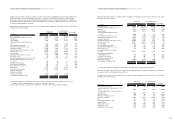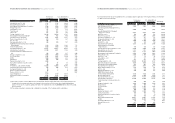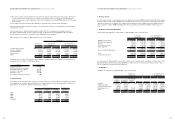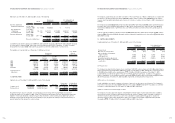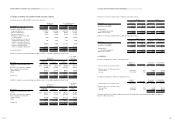Hyundai 2002 Annual Report Download - page 32
Download and view the complete annual report
Please find page 32 of the 2002 Hyundai annual report below. You can navigate through the pages in the report by either clicking on the pages listed below, or by using the keyword search tool below to find specific information within the annual report.
Debt securities held for investment are classified as either held-to-maturity investment debt securities or available for sale
investment debt securities at the time of purchase. Held-to-maturity debt securities are stated at acquisition cost, as
determined by the moving average method. When the face value of a held-to-maturity investment debt security differs
from its acquisition cost, the effective interest method is applied to amortize the difference over the remaining term of the
security. Available-for-sale investment debt securities are stated at fair value, resulting valuation gain or loss reported as a
consolidated capital adjustment within shareholder’ equity. However, if the fair value of a held-to-maturity or an available-
for-sale investment debt security declines compared to the acquisition cost and is not expected to recover (impaired
investment security), the carrying value of the debt security is adjusted to fair value, with the resulting valuation loss
charged to current operations. If the fair value of the security subsequently recovers, in the case of a held-to-maturity debt
security, the increase in value is recorded in current operations, up to the amount of the previously recognized impairment
loss, and in the case of an available-for-sale debt security, the increase in value is recorded in capital adjustments.
The lower of the acquisition cost of investments in treasury stock funds and the fair value of treasury stock included in a
fund is accounted for as treasury stock in consolidated capital adjustments.
Property, Plant and Equipment and Related Depreciation
Property, plant and equipment are recorded at cost, except for assets revalued upward in accordance with the Asset
Revaluation Law of Korea. Routine maintenance and repairs are expensed as incurred. Expenditures that result in the
enhancement of the value or extension of the useful lives of the facilities involved are treated as additions to property, plant
and equipment.
Depreciation is computed using the straight-line method based on the estimated useful lives of the assets as follows:
Before 2002, the Company and Kia, one of its domestic subsidiaries, had capitalized a portion of financial cost including
interest expense and similar expenses in conformity with Financial Accounting Standards of Republic of Korea. However,
in 2002, the Company elected to adopt the accounting method of charging all financing cost to current operations in
accordance with Statement of Korea Accounting Standards (SKAS) No. 7 – Capitalization of Financing Costs. This
Statement is effective for fiscal years subsequent to December 31, 2002 but early adoption in 2002 is permitted. This
Statement provides that all financing cost must be charged to current operations but capitalization of financial cost can be
acceptable under certain conditions. In accordance with SKAS No. 7, in the first effective fiscal year, the company should
elect one of such accounting methods for financing cost as its accounting policy and consistently apply it. If the
accounting method of charging all financing cost to current operations is selected, it would result in an accounting change
and in accordance with this Statement, this change is accounted for using prospective approach. This change of
accounting method resulted in the decrease of consolidated net income and assets by 55,515 million (US$46,247
thousand), respectively, compared with the results based on the previous method. The Company and its subsidiaries
capitalized financial cost of 103,083 million (US$ 85,874 thousand) as part of the cost of constructing major facilities and
equipment in 2001.
Intangibles
Intangible assets are stated at cost, net of accumulated amortization. Subsequent expenditures on intangible assets after
their purchases or completions, which will probably enable the assets to generate future economic benefits and can be
measured and attributed to the assets reliably, are treated as additions to intangible assets.
HYUNDAI MOTOR COMPANY AND SUBSIDIARIES: Financial Statements 2002
Useful lives (years)
Buildings and structures 2 – 60
Machinery and equipment 4 – 50
Vehicles 2 – 21
Dies and moulds 2 – 12
Tools 2 – 12
Other equipment 2 – 12
Amortization is computed using the straight-line method based on the estimated useful lives of the assets as follows:
If the recoverable value of intangible assets is lower than book value, book value is adjusted to the recoverable value with
impairment loss charged to current operations.
In 2002, the Company adopted Statement of Korea Accounting Standards (SKAS) No. 3 – Intangible Assets. This
Statement, effective for fiscal years subsequent to December 31, 2002 but early adoption in 2002 is permitted, provides
more clarifications of accounting method of intangible assets including definition, scope, recognition, amortization and
valuation. Also, considering the trend in the automotive market, the Company shortened the estimated economic useful
lives for certain types of development costs and reclassified the ordinary development expenses and research expenses.
This accounting change resulted in the decrease of consolidated net income by 445,990 million (US$371,534 thousand)
compared with the results based on the previous method.
In 2002, Hyundai HYSCO, a domestic subsidiary changed the estimated economic useful life of development cost from
twenty years to ten years. This accounting change resulted in the decrease of consolidated net income by 1,775 million
(US$1,479 thousand) compared with the results based on the previous method.
Valuation of Receivables and Payables at Present Value
Receivables and payables arising from long-term installment transactions, long-term cash loans (borrowings) and other
similar loan (borrowing) transactions are stated at present value, if the difference between nominal value and present value
is material. The present value discount is amortized using the effective interest rate method. Effective interest rate ranges
from 8.25 percent to 10.00 percent in 2002 and is 10.0 percent in 2001.
Restructuring of Receivables and Payables
If principal, interest rate or repayment period of receivables is changed unfavourably for the Company by the court
imposition such as commencement of reorganization or by mutual agreements and the difference between nominal value
and present value is material, such difference is recorded in other expense as provision for doubtful accounts. The
difference is amortized using the effective interest method, with the amortization included in interest income or interest
expense.
Discount on Debentures
Discount on debentures, which is the difference between the issued amount and the face value of debenture, is presented
as a deduction from to the face value of debentures and amortized over the redemption period of the debenture using the
effective interest rate method. Amortization of discount is recognized as interest expense on the debenture.
Accrued Severance Benefits
Employees and directors of the Company and its subsidiaries are entitled to receive a lump-sum payment upon
termination of their service based on the applicable severance plan of each company. The accrued severance benefits that
would be payable assuming all eligible employees of the Company and its domestic subsidiaries terminated their
employment amount to 2,592,509 million ($2,159,704 thousand) and 2,143,955 million ($1,786,034 thousand) as of
December 31, 2002 and 2001, respectively.
Accrued severance benefits are funded through a group severance insurance plan and individual severance insurance
plan. The group severance insurance deposits under this insurance plan are classified as other assets. Subsequent
provisions are funded at the discretion of the Company. Group severance insurance deposits may only be withdrawn for
the payment of severance benefits. Individual severance insurance deposits, of which a beneficiary is a respective
employee, are presented as deduction from accrued severance benefits. Actual payments of severance benefits amounted
to 308,575 million ($257,060 thousand) and 288,906 million ($240,675 thousand) in 2002 and 2001, respectively.
HYUNDAI MOTOR COMPANY AND SUBSIDIARIES: Financial Statements 2002
Useful lives (years)
Goodwill (Negative goodwill) not to exceed 20 years
Development costs 3 – 10
Other 4 – 20
62 63


